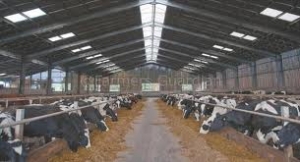Housing & Construction
Continuous Housing of Dairy Cows

Context
Interest in keeping dairy cows indoors comes from developments in animal genetics, health and nutrition, which have contributed to a cow’s milk output increasing by 80 litres/year over the past 20 years.
In exclusively grassed-based systems, a cow’s milk yields are 4000-5000 litres. In mixed housing and grazing systems, where cow’s diets are supplemented by concentrates, yields can reach 6000-8000 litres. Continuously-housed systems can see yields rise to more than 10,000 litres.
High-quality pasture alone does not provide balanced diets for maximum feed efficiency as cows’ stomachs cannot fully digest and make best use of the nitrogen in grass. There is also a limit to the amount of grass cows can graze, which limits a cow’s milk yields to below its genetic potential.
Continuous housing presents an opportunity to develop feeding strategies to utilise a cow’s use of feed, increase intake and realise a cow’s full potential for producing milk. However, there are concerns animal welfare may be compromised.
The welfare standards of a dairy herd - regardless of size or its housing system - are underpinned by the skills of the stockman looking after the animals. The production system does not necessarily directly relate to a cow’s health and welfare. Better advice is needed to allow the industry to fully understand the health and welfare consequences of different types of housing.
Background
Only about five per cent of the UK dairy herd is continuously housed. Across Western Europe, the figure ranges from zero per cent in Sweden (where grazing is mandatory through legislation) to more than 50 per cent in the Alpine region and in Italy. Continuous housing is common in regions where grass is in short supply or where the climate is unsuitable for growing grass or too harsh for the animal. In the UK, the majority of cows are housed in winter and grazed in summer in periods of about six months each.
Plans to establish large, continuously-housed dairy units in the UK have attracted much media attention and opposition from lobby groups over concerns about pollution, disease and animal welfare, disposal of manure and the operation’s carbon footprint.
Current position
Many dairy buildings are relatively old and cow size has increased progressively over recent decades. Consequently, cubicles, feeding passages and ventilation in older buildings may have become incapable of maintaining good cow health and welfare, regardless of the feeding system.
Continuous housing of cows presents opportunities for skilled cow management, especially from a nutritional perspective where diets can be tailored to meet the needs of individual cows or groups of cows, or for greater bio-security of the production unit.
As a result, continuous housing is often practiced with larger herds where economies of scale justify greater investment in expert labour and specialist advice, as well as higher capital expenditure on buildings and equipment. Larger herds also allow herd ‘grouping’, where cows can be grouped so their needs can be more easily met and stress on the animals is minimised.
However, there is concern continuously-housing cows means their normal behaviour is compromised. Scientific evidence suggests the behaviour of cattle housed indoors may be different from that of those housed outdoors, but that there are no behavioural differences between continuously housed cattle and those that are merely over-wintered.
Solving problems with one aspect of animal behaviour may create problems with another. For example, grazing may be perceived as being more ‘natural’, but it may also deprive the animal of shade and create periods of hunger, discomfort and stress in hot, dry weather when grass growth is restricted by lack of water. Given the choice, in summer cows prefer to be fed indoors rather than graze, especially in daytime when temperature and humidity are at their highest. This might be interpreted as an expression of a preference for shade.
Dairy herds that practice continuous housing require a high level of management to ensure health and welfare standards for the cows are met. The main risks associated with continuous housing are inadequate management and stockperson skills to prevent and deal with animal health and welfare issues and insufficient capacity to store and use manure efficiently as a fertiliser or as a substrate for anaerobic digestion. There are also issues around inadequate investment in buildings and staff to ensure the enterprise is run both efficiently and ethically.
Note
The British Society of Animal Science and the British Cattle Veterinary Association have recently established an expert working group to develop detailed guidelines for the continuous housing of dairy cows, paying particular attention to animal welfare.
Acknowledgements
J M Wilkinson, P C Garnsworthy and J N Huxley, University of Nottingham, for the British Society of Animal Science.
April 2012














